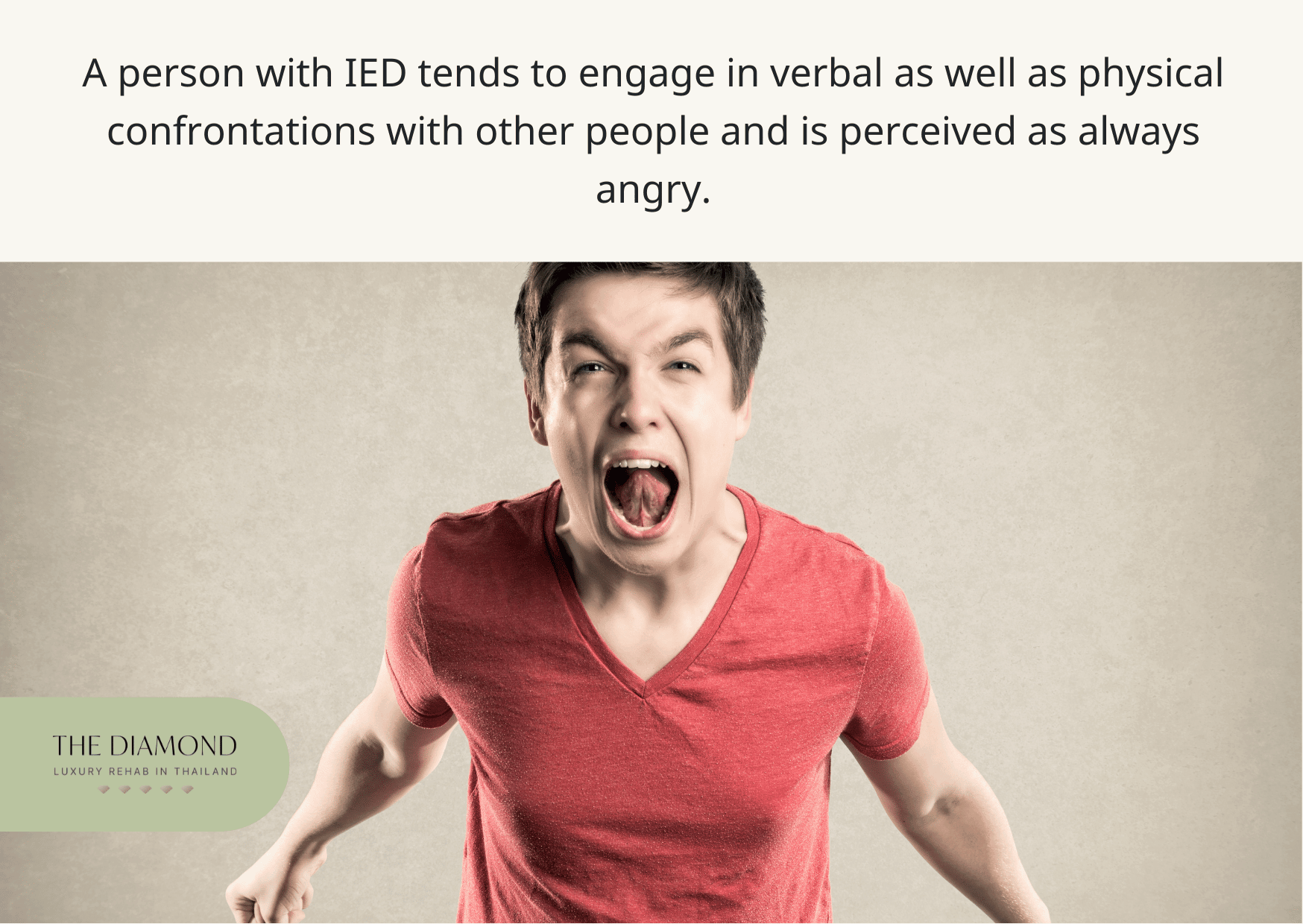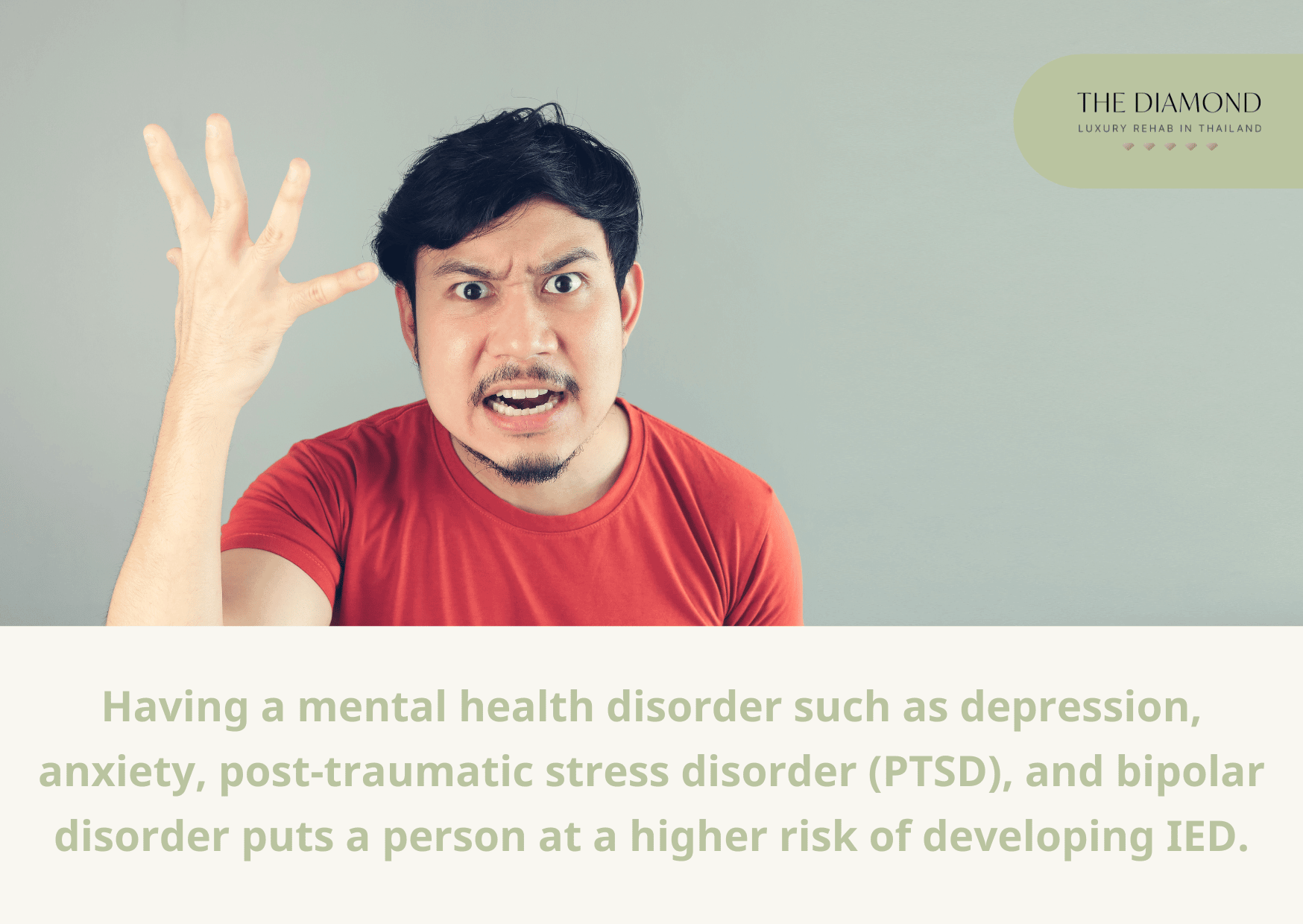7 Ways on how to prevent Intermittent explosive disorder
Table of content
- 1. Exercise relaxation methods
- 2. Learn how to communicate more effectively
- 3. Change your surroundings
- 4. Maintain your treatment plan
- 5. Avoid using mood-altering drugs
- 6. Use problem-solving techniques
- 7. Create new mental models (cognitive restructuring)
- What is Intermittent explosive disorder?
- Why should you avoid Intermittent explosive disorder?

Intermittent explosive disorder is a form of impulse control disorder that includes anger outbursts and violent behaviors that aren’t proportionate to their triggers. A person with intermittent explosive disorder overreacts and becomes aggressive or violent even if the situation isn’t that serious and doesn’t require such a response.
Although intermittent explosive disorder episodes are unpredictable and occur suddenly, there’s a lot an affected person is able to do to prevent them. The best prevention strategies include relaxation methods, improving communication, changing surroundings, adhering to the treatment plan, avoiding mood-altering drugs and substances, improving problem-solving skills, and cognitive restructuring.
Symptoms of intermittent explosive disorder include repeated aggression, property damage, violence, and extreme mood swings that make a person easily irritated or cause temper tantrums.
A person with intermittent explosive disorder feels guilt, embarrassment, and shame for their irrational anger and other actions. However, they don’t know how to react differently. The main objective of the prevention methods is to improve the way they react to different people and situations.
1. Exercise relaxation methods
Relaxation methods are techniques that allow us to refocus attention on something calming and increase awareness of the body. These methods are meant to manage stress, anxiety, anger, and other negative thoughts and feelings, which are common among people with intermittent explosive disorder. The best relaxation methods for preventing IED are listed below.
- Deep breathing
- Meditation
- Yoga or Tai Chi
- Music and art therapy
- Reading and/or writing
- Painting
- Gardening
- Massage
- Aromatherapy
- Visualization (mental images or visual journey to a calming location)
Relaxation methods promote calmness, which works for people with IED. They work because these strategies minimize or downplay a person’s response to negative stimuli. In turn, they prevent IED episodes. However, not every relaxation method works for all patients with IEDs, as different people react to different strategies. The goal is to give them a try and find the one that works best to promote relaxation and calmness.
2. Learn how to communicate more effectively
Learning how to communicate more effectively refers to improving interaction with other people. This means a person with IED needs to learn to convey their emotions, express them properly, and to actually listen to what others have to say and understand their point of view. Tips for improving communication to prevent IED are listed below.
- Be an engaged listener without judging
- Pay attention to body language
- Express yourself and your thoughts or emotions
- Accept that communication with someone doesn’t necessarily imply two people have to agree on every topic
- Feel free to ask questions
- Control emotions and don’t overreact to someone’s words, even if you don’t agree
- Avoid using harsh language
- Think before you speak
Communication is a major problem for people with intermittent explosive disorder. A patient with IED doesn’t know how to express their emotions, and their relationships with other people are jeopardized due to communication problems.
Learning to communicate more effectively allows a person with IED to channel their emotions and thoughts into a healthier behavior pattern. Instead of reacting with fury, a person uses verbal communication to explain their point of view.
It helps them understand others. Effective communication is a type of interaction where both sides are heard and understood. This minimizes angry outbursts and prevents IED episodes.
3. Change your surroundings
Changing your surroundings includes stepping away from the situation or avoiding environments or people that upset you and trigger aggressive behaviors. The tips for preventing IED by changing your surroundings are listed below.
- Know triggers of aggressive outbursts in your surroundings
- Identify people who trigger violent reactions
- Socialize with people that generate pleasant emotions
- Spend time in nature
- Find a healthy way to manage stress
- Practice saying positive things
- Live in the moment
- Stay cordial with negative people, but choose not to react to things they say or do
A person’s environment plays an important role in their behavior. People with intermittent explosive disorder aren’t an exception. In certain situations, the environment or specific people trigger aggressive reactions and violent outbursts. For that reason, changing the environment is crucial for the prevention of IED episodes. By changing the negative environment to a positive one or reducing the exposure to it, a person avoids getting triggered to react disproportionally.

4. Maintain your treatment plan
Maintaining a treatment plan refers to adhering to the doctor-recommended measures for the management of IED and its episodes. The tips for maintaining a treatment plan to regulate IED are listed below.
- Attend therapy sessions regularly
- Take medications the doctor prescribed and stick to the recommended dosage
- Practice coping skills
Intermittent explosive disorder and its episodes can be unpredictable. Without adequate treatment, it’s difficult for a person to function at work, home, school, or other environments. Maintaining the treatment plan helps prevent future episodes of IED. That happens because the main goal of treatment is to enable patients to manage their anger and control inappropriate responses.
5. Avoid using mood-altering drugs
Mood-altering drugs are substances that act as depressants and stimulants, i.e., these are compounds that elevate a person’s mood or bring it down. These substances include alcohol, illicit drugs, prescription depressants, and stimulants (unless prescribed by a healthcare professional).
People with IEDs often end up feeling ashamed or embarrassed for their actions. To tackle these emotions, they use drugs or drink alcohol. Not only does this lead to substance use disorder, but it additionally aggravates IED and increases the frequency of violent episodes. The tips for preventing IED episodes by avoiding mood-altering drugs are listed below.
- Don’t ignore your emotions; express them
- Apologize for your behaviors and actions
- Commit to making positive changes in your life
- Meditate or practice yoga
- Take a walk every day
- Make a gratitude list
- Become more mindful and appreciate little things in life
While using mind-altering drugs seems like a good idea to deal with embarrassment or shame, it does more harm than good. Avoiding these substances allows a person with IED to deal with their emotions more healthily and thereby stabilizes their mood. Instead of drinking to forget those emotions, it’s more important to process them and thereby improve relationships and reactions to negative stimuli.
6. Use problem-solving techniques
Problem-solving techniques are strategies concerned with defining a problem, identifying the cause of the problem, and finding and implementing solutions. In this case, problem-solving techniques serve to help patients with IEDs to find solutions to problems that trigger their aggressive behaviors. Tips for using problem-solving techniques to prevent intermittent explosive disorder are listed below.
- Define a problem as precisely as possible
- Write down why the problem is frustrating or why it causes anger
- Brainstorm solutions to resolve the problem in a way that doesn’t involve violence and aggression
- Avoid jumping to conclusions
- Try different approaches or solutions
- Don’t take everything personally
- Communicate
Problem-solving techniques help prevent IED because people often don’t know how to react differently. A person with IED usually doesn’t know how to channel their negative emotions properly, or they don’t know how to respond to certain situations in a healthy manner. Employing problem-solving techniques and trying to come up with solutions creates a sense of having a plan in mind. This results in a higher chance of preventing IED episodes. Even if a frustrating problem isn’t fixed right away, it helps a person refocus their energy and thereby avoid using violence and aggressive behavior.
7. Create new mental models (cognitive restructuring)
Cognitive restructuring is defined as a technique that involves changing or restructuring a person’s thinking patterns and beliefs. The best methods for cognitive restructuring and creating new mental models are listed below.
- Read success stories about people who managed to prevent IED episodes
- Make theories about different situations and visualize reacting to them in a positive manner
- Keep a journal of all ideas and observations
- Read books or join workshops and online courses about cognitive restructuring
- Go to therapy regularly
Psychotherapy, such as cognitive-behavioral therapy (CBT), is an effective strategy for cognitive restructuring. A study by Costa et al., published in the July to September 2018 issue of the Brazilian Journal of Psychiatry found that CBT focused on anger management and healthy coping mechanisms plays a role in the treatment of IED and its prevention.
Creating new mental models helps prevent IED because it changes the way a person perceives and reacts to what’s going on around them. Cognitive restructuring teaches people with IED to identify negative thoughts and behaviors that they get to replace with more positive alternatives. They improve coping mechanisms and change the way they handle situations that trigger their anger.
What is Intermittent explosive disorder?

Intermittent explosive disorder is a mental health condition indicated by repeated and sudden episodes of aggressive and impulsive behaviors that include physical or verbal attacks. A person with intermittent explosive disorder reacts disproportionally to the situation that triggered the episode.
American Psychiatric Association’s Diagnostic and Statistical Manual of Mental Disorders, fifth edition (DSM-5), published in 2013, classifies intermittent explosive disorder among impulse control disorders. This category also includes pyromania and kleptomania.
Although intermittent explosive disorder term is relatively young, the condition was recognized decades ago. The American Journal of Psychiatry explains that the term intermittent explosive disorder first appeared in the DSM-3, published in 1980. However, DSM-1 from 1952 included a condition called the disorder of impulsive aggression. More precisely, at that time, it was called passive-aggressive personality, aggressive type. That disorder was indicated by the persistent reaction to frustration with temper tantrums, irritability, and destructive behavior.
In 1968, DSM-2 was published, and it featured a different term for the same disorder. The term was explosive personality disorder.
What are the symptoms of Intermittent explosive disorder?

The symptoms of intermittent explosive disorder are listed below.
- Physical and/or verbal aggressiveness
- Uncontrollable anger and angry outbursts
- Damaging property
- Uncontrollable irritability
- Tremors
- Tension
- Rapid heartbeat
- High energy levels
- Racing thoughts
- Chest tightness
- Headache
- Low frustration tolerance
- Short periods of emotional detachment
Signs and symptoms of IED disorder revolve around aggressive outbursts that appear suddenly. The average duration of an aggressive episode is up to 30 minutes, Mayo Clinic reports. In some people, the episodes of intermittent explosive disorder symptoms occur frequently, but in others, they are weeks or months apart.
When it comes to signs, symptoms, and effects of IED, it’s important to mention not every case of anger is considered to be a form of this disorder. Instead, symptoms of aggression are out of proportion to the situation. In other words, a person tends to overreact and become so aggressive that they verbally or physically attack someone or damage property.
After the episode, a person with an IED tends to feel tired or relieved. Sometimes, people with this condition feel shame and guilt, or they regret their actions.
It’s important to mention that people with intermittent explosive disorder are aware their actions are wrong, but they feel like they have no way of controlling them.
Why should you avoid Intermittent explosive disorder?

You should avoid intermittent explosive disorder because the condition causes a wide range of complications. One of the biggest consequences of intermittent explosive disorder, and other anger disorders, is an impaired relationship with other people, especially the significant other, family, and close friends.
A person with IED tends to engage in verbal as well as physical confrontations with other people and is perceived as always angry. Their actions lead to family stress, divorce, failed friendships, and other problems in interpersonal relationships.
A person with intermittent explosive disorder tends to react in an angry manner, which tends to be particularly difficult in school or at work. These behaviors make it hard for a person with IED to get along with school or work colleagues. As a result, their performance ends up being unsatisfactory, leading to job loss, poor grades, financial problems, and even trouble with the law.
Physical health consequences are another reason to avoid IEDs. Complications associated with intermittent explosive disorder extend to high blood pressure, ulcers, chronic pain, increased risk of cardiovascular diseases, and events such as heart disease and stroke.
Additionally, intermittent explosive disorder worsens mental health problems such as depression and anxiety. In an attempt to deal with their aggressive emotions and behaviors, a person with IED tends to resort to alcohol and drugs, which potentially leads to addiction.
Intermittent explosive disorder affects different aspects of a person’s life, and its complications run deep, which is why it’s important to follow the seven measures listed above to prevent it.
Who is affected by Intermittent explosive disorder?
Intermittent explosive disorder mainly affects children aged six or older and adolescents. The disorder additionally affects adults younger than 40 years old. Both genders are likely to develop IED, but the prevalence is higher in males.
An adolescent’s perception of social status is strongly associated with mental health. For example, if an adolescent perceives their social status as unfavorable or deems themselves as an outcast, it affects their behavior patterns.
Children and adolescents from dysfunctional households are usually affected by intermittent explosive disorder.
What are the risk factors for developing Intermittent explosive disorder?

Risk factors for developing intermittent explosive disorder include younger age, being male, history of physical abuse and trauma, history of mental health disorders and substance abuse, and exposure to explosive behaviors and violence in the household at an early age.
To elaborate on the above mentioned risk factors, children and adolescents are more likely to develop IED than adults. However, it is unclear why males are more susceptible to explosive anger disorder than females. One explanation is that it is due to higher testosterone levels than in women. However, more research on this topic is necessary.
Children growing up in abusive and violent households are more likely to develop IEDs later in life. Constant exposure to violence, aggression, and an overall dysfunctional environment prevents a child from developing healthy coping mechanisms.
When that happens, the affected children don’t know how to process their emotions or adopt healthy and positive behavior patterns. This is particularly the case among children who were victims of physical and verbal abuse.
Additionally, having a mental health disorder such as depression, anxiety, post-traumatic stress disorder (PTSD), and bipolar disorder puts a person at a higher risk of developing IED. The same happens for persons addicted to alcohol or other drugs and substances. For example, a 2018 study by Medeiros et al., published in the journal Psychiatry Research found that significant correlations were observed between the intensity of depressive symptoms and elevated assault scores, impaired social judgment, and heightened aggressive behavior. Scientists concluded that managing depression is an important strategy for the treatment of intermittent explosive disorder.

How is Intermittent explosive disorder diagnosed?
Intermittent explosive disorder is diagnosed with the help of a physical exam, psychological evaluation, and the criteria from DSM-5.
The main purpose of a physical exam is to rule out physical conditions or substance abuse that possibly trigger aggressive and violent behaviors. Physical exams include lab tests. On the other hand, during psychological evaluation, a mental health professional asks questions about symptoms, feelings, thoughts, and behaviors. They use the DSM-5 criteria for intermittent explosive disorder to determine whether a patient’s symptoms classify as IED.
Generally speaking, there is no intermittent explosive disorder test (or IED test), but there is a screening tool for this disorder. IED screening questionnaire, otherwise known as IED-SQ, evaluates a person’s risk for developing this condition. The questionnaire detects symptoms and determines whether a patient needs additional evaluation. The screening tool is not used to provide an official diagnosis for IED, though.
Is Intermittent explosive disorder common?
Yes, intermittent explosive disorder is relatively common. The National Institutes of Health reported that throughout their lives, 11.5–16 million Americans, or up to 7.3 percent of adults, experience intermittent explosive disorder (IED), depending on how precisely it is characterized.
Furthermore, a research article written by Emil Coccaro last updated in December 2021 by UpToDate revealed that the frequency of intermittent explosive disorder throughout the course of a lifetime was close to 4%, and it was nearly 3% in the previous year. Approximately 8 and 6 percent of people reported having engaged in significant, physically abusive behavior at least three times a year in their lifetime and the previous year.
The JAMA Psychiatry published a study by McLaughlin et al., in 2012 that found that IED is a highly prevalent, persistent, and severely impairing mental health disorder among adolescents.
At the same time, it’s under-treated and understudied. The same study reported almost two-thirds of adolescents (63.3% of subjects) experienced anger attacks that involved violence or damaging property. Of these, 7.8% met the criteria for IED. The disorder had early onset, and 80.1% of adolescents with IED developed it around the age of 12.
Finally, a study by Scott et al., published in the 2020 issue of the journal Epidemiology and Psychiatric Sciences concluded that the inconsistent results across population and clinical investigations imply that IED is a condition that needs much more investigation. These disparities happen because certain studies focus on DSM-4 and others on DSM-5 criteria.All these point to the possibility that the prevalence of intermittent explosive disorder is a lot higher than what is currently known.

